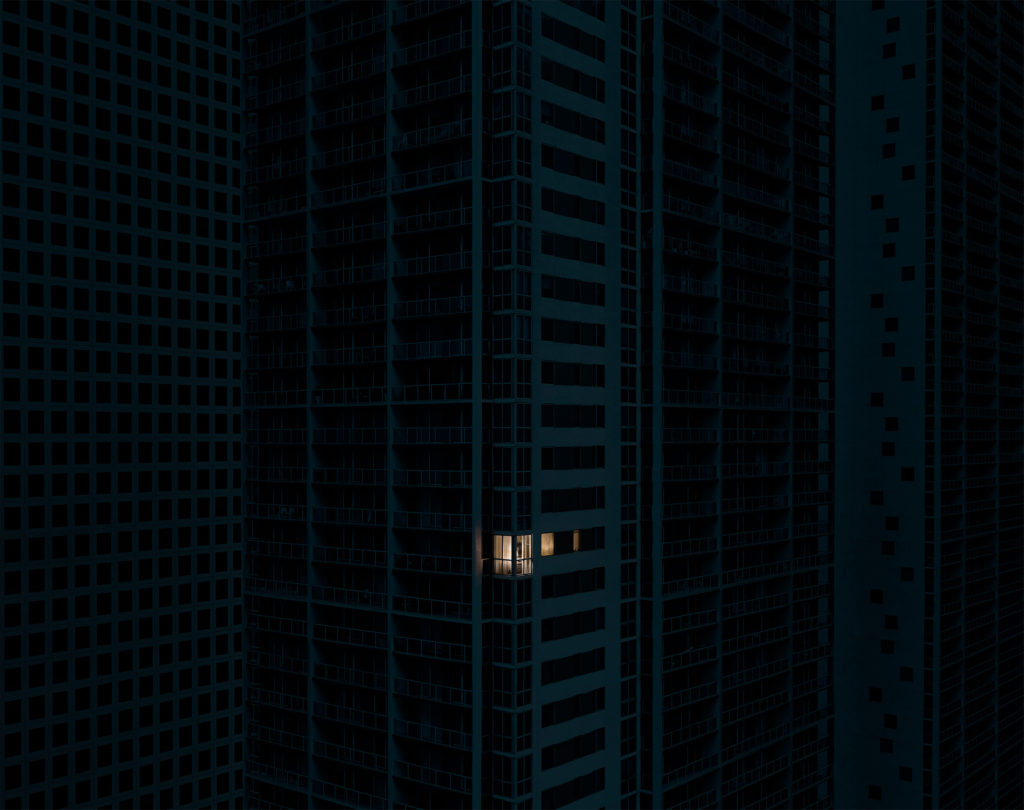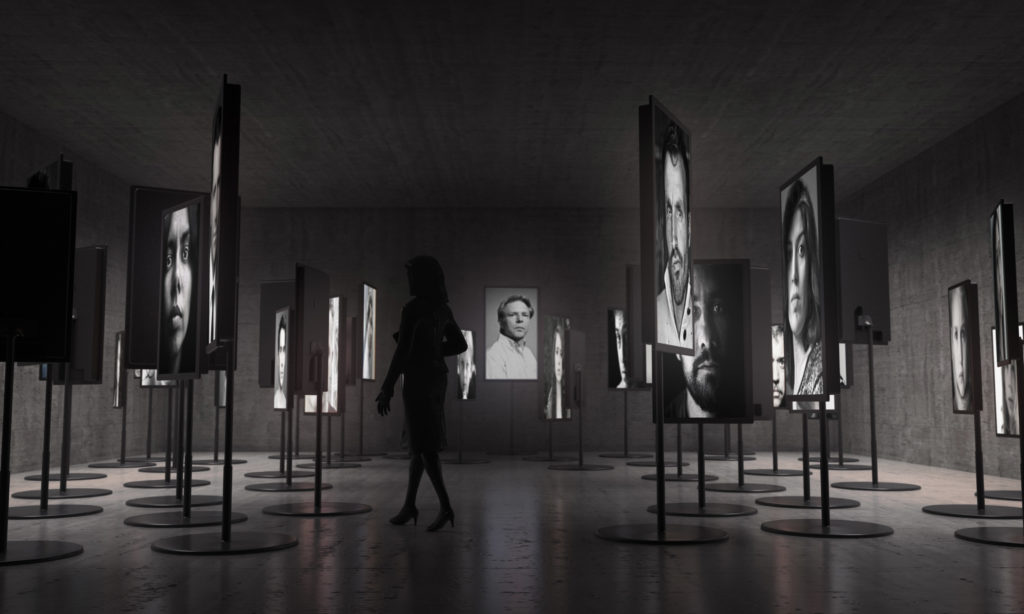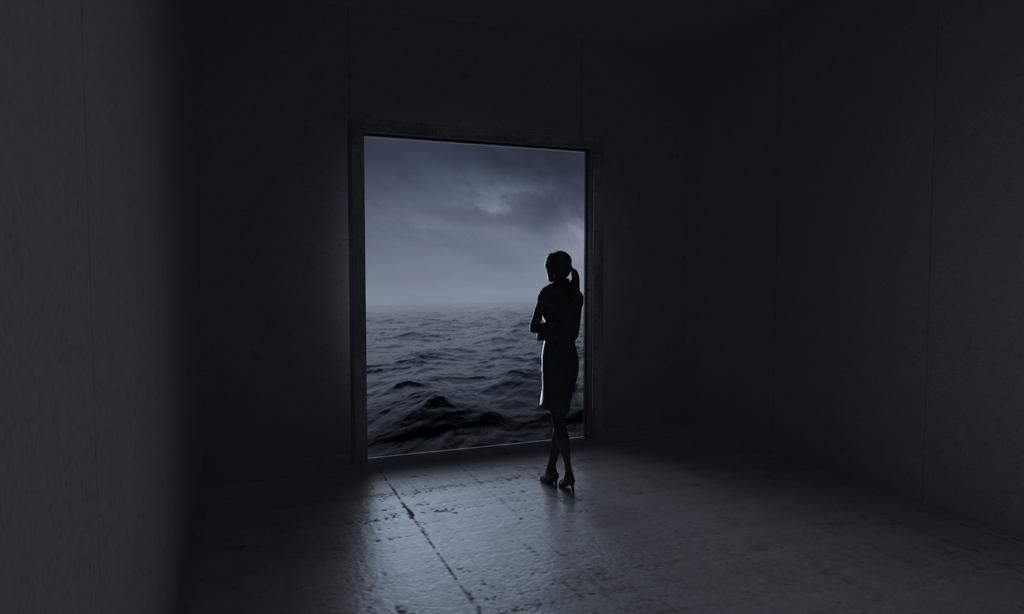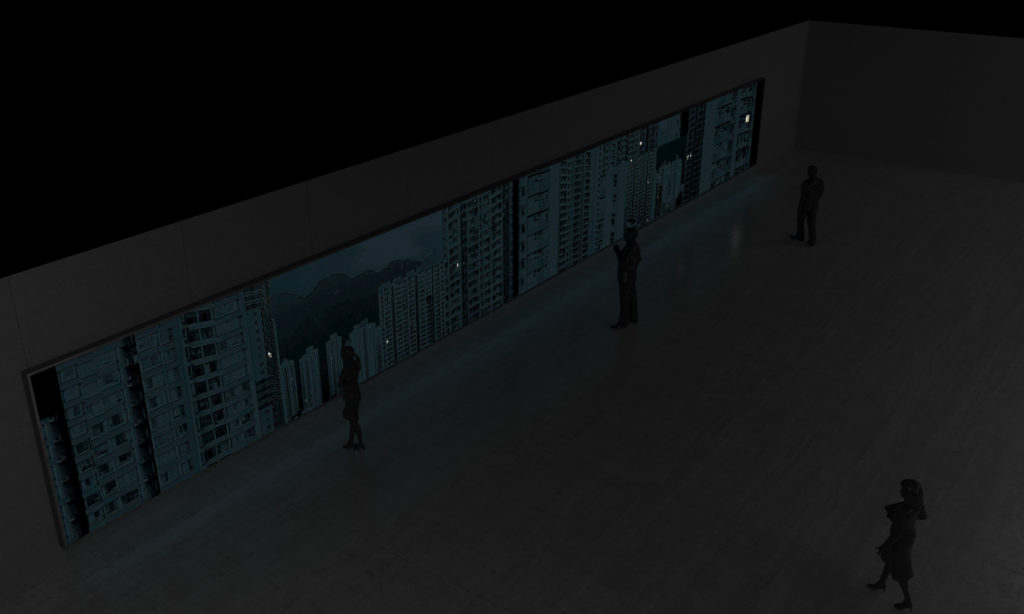Aristotle Roufanis
Aristotle Roufanis (b. 1983 Athens, Greece) is a visual artist, whose work focuses on patterns, textures and human interactions defined by the condition of urban life and architecture.
Fascinated by how humans build the environments they live in, he has travelled the world extensively, creating work that combine meticulous digital editing and experience design with a very personal artistic vision.
His work has been exhibited among others at Miami Photo Festival, Zeitz MOCAA Cape Town, the 3rd Beijing Photo Biennale, the Copenhagen Photo Festival and the Royal Academy of Arts in London.
Publications include Wired, Artsy, The Art Newspaper, British Journal of Photography, Creative Review, Cheese! by Konbini, Petapixel, the Best of Behance galleries and many others, both online and in print.
He lives and works in Athens, Greece.
Alone Together (2017-ongoing)

About the project
Since 2016, Aristotle Roufanis has been creating super-high-definition images of urban landscapes that are an intimate look into the lives of city-dwellers and their loneliness. The large composite images of his ongoing Alone Together series are the result of dedicated observation, as he photographs the cities he visits from dusk till dawn: after setting up his equipment on a high-rise or hill, the artist proceeds to patiently capture the city below click-by-click, in a process that can take several hours.
A civil engineering graduate, Aristotle Roufanis has always been fascinated by architecture, and particularly the patterns and sheer scale of large cities. Interested in the many contrasts and the amount of information one can collect through reading an urban landscape, the artist has often turned his lens to urban architecture in the past. Alone Together combines several themes that have appeared in Aristotle Roufanis’ work so far but merges them in a very skilful and refined way.
Apart from it being a feat of technique and skill, the sheer size and extreme amount of detail seen in Roufanis’ images have a very particular emotional impact: they make the urban landscape clearly visible all across their surface, which is something we cannot experience when looking at a vast expanse with naked eye. This also makes the images lose their depth and become flat, like a veil that protects the tender humanness hidden behind it.
Composition and balance in these works are less about form and color and more about organisation of content: which windows are kept illuminated within the sea of dark anonymous apartment buildings, and what do they contain? A sofa, a painting, a person behind a curtain: all these glimpses of an otherwise uneventful evening after work (or maybe the last excruciating minutes of a long sleepless night) are transformed into dramatic events full of emotional tension.
The starting point for this project was the artist’s own experience as an expat in London a few years ago. His initial observations of people tending to feel isolated in big cities led to further research into the phenomenon of urban loneliness in modern societies. This revealed that the issue is so widespread that it is often described as an epidemic. In the US alone, rates of loneliness have doubled in the last 50 years; according to a survey, nearly half of Americans report sometimes or always feeling alone or
left out.
London, Paris, Hong Kong, Miami, Athens: for Aristotle Roufanis, urban habitats and the loneliness of city dwellers are surprisingly the same wherever you go. By isolating only a few illuminated windows in each photo, the artist seeks to raise awareness about the epidemic of loneliness in big cities and at the same time take a positive stance about it. In his own words: “The bigger the city, the lonelier we feel. It is important for people to understand that although lonely, they are not alone. Individuality
does not equal to alienation.”
Works under development
Avoiding Eye Contact Installation (working title)

In an account describing the emotional toll of being a homeless person in Australia, Gregory P. Smith says that “for the most part, to be homeless is to be see-through” and that passers-by looked right through him “as if I was made of glass”. This actively isolating social behaviour is causing all sorts of issues with the self-esteem of homeless people, and in many ways is creating a vicious cycle for them, making the homeless less likely to seek help or change their habits. At the same time, feeling empathy about the homeless on this issue is challenging, because most people find it difficult to grasp: intimate contact and direct communication is part of a healthy, integrated social person’s everyday life, and and it is hard for such a person to imagine how it would be otherwise. This is why the activist platform Invisible People campaigns for the humanisation of homeless people, and believes that the first step in solving the problem of homelessness is to acknowledge that its victims are people too.
As part of his work, Aristotle Roufanis often seeks to put the viewer in the place of a vulnerable person and create (to the viewer) the same feelings or impressions an isolated person has. To this end, the artist is currently developing a room-size installation that puts the viewer in the uncomfortable position of being ignored by everybody else in the room.
The room is filled with screens showing virtual people controlled by AI. These virtual people are like talking heads inside the screens, and they interact with their neighbours (i.e. the other virtual characters) by looking at them and establishing dialogues. The monitors are mounted on vertical axes that can rotate in either direction on cue, a feature also controlled by computer algorithms.
As the viewer enters the room, the virtual people are chatting with one another or looking to various directions. At the same time, they are avoiding eye contact with the viewer constantly: as he or she is walking across the room, the screens rotate discreetly so that the viewer is unable to get a direct look at them. Even a sudden turn of the head (as if to catch a monitor by surprise) will cause the monitor to rotate just enough to avoid the viewer’s gaze.
Depending on budget, the walls and ceiling of the room can also act as projected surfaces that extend the scene digitally ad infinitum. The overall visual result is like an endless hall of mirrors, only in this case the mirrors are ‘talking portraits’ of virtual people socialising and deliberately ignoring the viewer.
This installation will be produced using techniques used in the gaming industry, realised in an augmented reality setting. At a later stage the monitors with the faces can be mounted on robotic stands with wheels that move across the room in a realistic manner.
The Ocean Video Sculpture (working title)

Water is a very expressive element, in the sense that it can be used to evoke all kinds of feelings, from fear and pressure to love and relaxation. A vast expanse of water, like an ocean or a lake, illustrates the feeling of ultimate isolation. Also,the ocean has been used countless times as a metaphor for isolation and for being surrounded by the unknown. Being completely surrounded by water is a very frightening experience, especially because one has no sense of direction, speed or time.
An image of the ocean will be used in one of the 360 installations of the container sculpture described above. A different version of the same concept is in the form of a video sculpture: a gate or window on the wall that contains a video projection of an endless expanse of water. By framing the video and making it smaller it creates a different, more personal relationship with the viewer and makes them the focal point of this encounter.
The work evokes a sense of purity and awe, just like when standing on the coast looking out towards the sea. The video inside the gate or window will be edited to include changes in the time of day, clouds, wind velocity and wave height/frequency. As these parameters change, the feeling evoked by the work also changes. The experience of the work will be enhanced with multi-sensory stimuli like sound, blowing wind and mist from hidden fans and even recreating the smell of sea breeze chemically. The more one observes the work, the more they become attuned to its rhythm. There is a possibility that the combination of these parameters will be able to affect the heart rate of the viewer while they watch. In order to be able to manipulate the above parameters in real time and in a realistic way, the whole image needs to be computer generated based on very accurate
physical models. It will be essentially impossible to tell whether the image of the ocean projected is a real or an artificial one. This has the advantage that the video will be able to be exported at a very high resolution, which will allow a more realistic projection on a high-definition flat screen. But the most important part is that the affect of the image will be able to change constantly, from calmness to thunderstorm and small waves to large ones. The more one observes the work, the more their emotions will change.
The HK multimedia installation

For Aristotle Roufanis, the city of Hong Kong is a place where he often returns to. The city’s architectural extremes have become a subject of his work several times, especially as part of his Alone Together series. Being one of the most populous urban areas in the world, Hong Kong displays a very unique and recognisable architectural image. What Roufanis is interested in more however is not the gleaming skyscrapers on the city’s seafront, but the endless rows of residential apartment buildings in the New Territories.
For this imposing video installation, the artist has created a solemn video of
these apartment buildings at night using a drone camera. The footage moves in a steady flow from right to left, with one apartment building coming one after the other in a steady rhythm. The effect is mesmerising as much as it is haunting: the artist has edited the video to repeat in an endless loop, creating the illusion that this is a city that never ends. The footage has been edited in the same creative way as Roufanis’ Alone Together series, where only a few illuminated windows shine through a deep blue night.
Using an in house developed ground breaking technique, the end resolution
of the footage will be up to 20k in length, resulting in a 5 projector continuous projection at an unbelievably high resolution. The video is presented as a large installation in the form of one, seamless moving image projected on a very long screen. This is made possible by coordinating several projectors to create a seamless moving image across the surface. The projection surface is very wide and taller that a person’s height in order to create an immersive experience. As the footage flows along the screen, visitors can choose to stand close to it or far away from it, or walk along it.
A spatial multi-channel audio system complements the work. The speakers are placed behind or above the screen to create a spatial audio environment that moves together with the video. The sound environment consists of many small music elements that stand out when you are close to the screen and merge into a larger composition when you walk away from it.
This work will also be available in smaller sizes and as a VR work.
Critical Responses
Michael Hardy — The Wired
“The images are nearly all-black except for the dozens of lighted windows scattered throughout the urban landscapes, evidence of tenuous human activity amid the darkened office blocks and apartment towers. Often, the people or objects inside the lighted windows suggest a narrative — the images repay the viewer’s close attention, especially at full size.”
Brian Allen — The Art Newspaper
“Aristotle Roufanis’s nocturnes of cityscapes are big, too, and just as bewitching. The emerging London-based artist captures the velvety darkness of brightly lit cities, animated by geometric shapes of light.”
Alina Cohen — Artsy
“For the series, Roufanis took thousands of pictures of the British metropolis from sunrise to sunset over multiple evenings, then spent six months stitching together new compositions. The results show high-rises that are mostly dark, except for one or two illuminated windows. The work recalls Stan Douglas’s recent “Blackout” series (2017)—it’s similarly haunting and cinematic.”
Maria Trujillo — Art Critique Magazine
“Even though the viewer can instantly see the breath of solitude, the artwork also has a cathartic effect – I am not the only one awake, and I am not the only one feeling desolate.”
Katerina Stathopoulou — Assistant Curator, Museum of Modern Art (MoMA), New York
“[Alone Together VIII] is stunningly executed – the single window of light in a deep and uniform sea of blue repetitious geometry. We see a sprawling, lifeless (and soulless) urban canvas, with the smallest signs of human activity. It plays on ideas of modern loneliness, of loss of social connection, of feeling alone and alienated, despite being surrounded by other city dwellers.
Of voyeurism and surveillance. These are grand and relatable themes for those who live in cities. It’s a meticulous composition, and the product of scrupulous, skilful digital editing – the result is spectacular, and well worth the effort.”
Cat Lachowskyj — British Journal of Photography
“The images are made using an advanced digital-editing technique that requires stitching together multiple files, ensuring every inch of the final photograph is in absolute focus. […] The enormous scale of the photographs – anywhere between three and five metres wide – compels viewers to feel completely submerged within each setting. While Roufanis acknowledges that the inspiration behind Alone Together is autobiographical, he also hopes that his viewers can take away more from the images than a simple memento of this private coexistence.”
Aesthetica Magazine
“Rewriting established genres such as portraiture, landscape painting and sculpture, a selection of pioneering practitioners [at London Art Fair] transcend the tangible to create forward-thinking, critically engaging pieces. […] Arte Globale [Gallery] reflects the state of the tangible modern world through Aristotle Roufanis’ photography. Concerned with the phenomenon of social alienation within built environments, Alone Together depicts vast metropoles illuminated solely by individual apartment
lights.”
Kiriakos Spirou — und. Athens
“We are used to seeing Athens as a vast grey sea of concrete, but in Aristotle Roufanis’s images the city is caught with its eyelids half-open; whether it’s about to go to sleep or just opened its eyes still half-dreaming is up to the viewer to decide. What surely strikes us nevertheless is the meticulous detail and amount of work spent on each image, as well as the sensibility by
which the photographer is eavesdropping on the city’s denizens, as if trying to hear their stories in the silence of the night. Maybe it’s through this listening in solitude that we might be able to come closer to each other after all.”
Lisa Miquet — Cheese! by Konbini
“Although the work may seem particularly dark, [Aristotle Roufanis] would like to add a ray of hope, reminding us that the nearest point of light is always closer than we imagine. A poetic way to approach the subject of social exclusion.”
Contact / CV
Please feel free to say hello by reaching out using the following email address, or social media
http://aristotle.photography
[…] interactive virtual gallery was made with the generous help and expertise of Aristotle Roufanis. Sound was a collaboration with […]